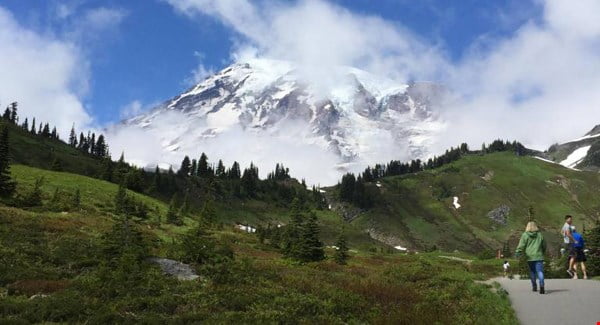
A case in point is the Pacific Northwest where trends are bucked with every new experience, generalisations are redundant and everything’s just that little bit different – and purposely so.
Bookended loosely by the Pacific Ocean at its westernmost edge and the Rocky Mountains to the east, the region is home to the US states of Oregon and Washington and the Canadian province of British Columbia as well as, depending on who you listen to, parts of Idaho and Montana.
At the centre of Pacific Northwestern life are the region’s two biggest urban centres: Portland, Oregon and Seattle, Washington.

It takes little time for the unique atmosphere and quirkiness that pervades Portland to sink in.
This is a city, that in the words of one local, knows it’s not on many top 10 lists of places to visit in the States and so set about creating a distinct culture and atmosphere that would set it apart from every other US city.
The fruits of that labour are abundantly clear in a town where locally produced trumps mass production, craft beer’s popularity far outstrips global brands and the Great Outdoors reigns supreme.
It’s a city of 600,000 makers and doers: designers, brewers, artists and cyclists – the epicentre of DIY culture; a liberal mecca of clean-cut living.
Named after its east coast namesake Portland, Maine the city very nearly became New Boston.
City founders Asa Lovejoy, a native Bostonian, and Francis Pettygrove of Portland, Maine were determined to name the new city after their respective hometowns and only settled the argument when Pettygrove won out on a coin toss on a score of two to one.
It may have come within a hair’s breadth of sharing a name with the city of JFK, Sam Adams and the Red Sox but Portland shares precisely none of its grittiness.
This is hipster central.

The trendy downtown Ace Hotel with its pared back decor is the perfect base from which to explore Portland’s relatively compact city streets.
With landmark attractions such as Stumptown Coffee Roasters, Union Way Shopping Arcade and Powell’s City of Books on your doorstep, it’s easy to jump right in and start getting to know the area.
Be warned, however, bookworms of all ilks risk never emerging from Powell’s with its nine colour-coded rooms housing 3,500 different sections and more than a million titles across an entire city block.
It’s title as the world’s largest independent new and used bookstore is well deserved and its rare book room – where capacity is limited and permission required to enter – is worth a few more minutes of your time.
En route to Powell’s is the Union Way Shopping Arcade which connects Portland’s West End with the Pearl District and plays host to nine independent retailers, having opened its doors in 2013 following the conversion of two former nightclubs.
The city’s retail core, Pioneer Place, is within walking distance from the Ace too with four blocks of shopping, dining and entertainment, including on my passing, a busker’s stirring version of Glen Hansard and Marékta Irglová’s Oscar-winning song, ‘Falling Slowly’, Undoubtedly the best way to see the city – America’s reigning bike capital – is, predictably, on two wheels.
Either on your own steam with little more than a map and an urge to explore or on a guided tour, as we opted for, Portland is a city that caters to bicyclists at every turn making it a joy to navigate.

Cycle paths adorn almost every route while local motorists show an almost unnerving deference to their two-wheeled friends.
That in itself should tell you all you need to know about the city’s bike culture.
A quick call into Pedal Bike Tours which operates a range of tours of downtown and the surrounding areas for between $59 and $99 or basic rentals from as little as $10 an hour will have you cruising around the city in no time.
As an added bonus, Kells Irish Pub is directly across the road for thirsty travellers to quench their thirst on their return.
Taking in the sights and sounds of downtown on the western side of the majestic and imposing Williamette River before skirting the water’s edge and heading towards the 102 year-old French-style château, Pittock Mansion, nestled in the city’s West Hills, our tour offered a nice mix of the urban and rural all at once.
From atop the hills, 900ft or so above sea level, the views of the city and the Cascade Mountain Range are well worth the pretty arduous trek needed to get there.
Nearby are other prominent attractions, including Oregon Zoo, the five and a half acre Portland Japanese Garden and the International Rose Test Garden.
In 1888, Georgina Burton Pittock, wife of Oregon newspaper publisher and business tycoon Henry Pittock of the aforementioned mansion, set up a rose tent in her garden which led a year later to the foundation of the Portland Rose Society and 25 years later the establishment of the rose test garden to protect hybrid European roses during World War One.
Ever since, the city’s love affair with roses has flourished culminating in the decision taken in 2003 to adopt “City of Roses” as Portland’s official nickname.
Since then, “Keep Portland Weird” has emerged as a favoured slogan of the city, paying homage to another of its defining characteristics.
The Lan Su Chinese Garden – an oasis of tranquility smack in the middle of downtown – is also worth visiting.

Nearby, Northwest 23rd Ave plays host to a range of boutique shops, cafés and bars while its equivalent on the eastern side of the river is Mississippi Street.
The east side, traditionally the industrial heart of the city, has in recent years undergone somewhat of a revival as the favoured home of the city’s artistic community and local producers.
And if you don’t think that artistic community includes brewers, you’re not just in the wrong city but on the wrong side of the wrong city, surrounded by most of Portland’s 70 or so craft breweries.
Even for a self-confessed craft beer sceptic, there’s worse ways to spend an evening than guzzling sample after sample of local beers on the Brewvana Southeast Walking Tour.
And if all that exploring and arduous beer tasting has worked up an appetite, it’s hard to be effusive enough in a recommendation of one of Portland’s newest restaurants, SuperBite where proprietors Greg and Gabi Denton pack a whole lot of taste into, as the name suggests, an array of small bites at pretty reasonable prices in the $3-$5 range for one of the dozen or so menu options – although quite a few are needed to quell the hunger.
Foodies will be at home in Portland generally which also boasts a lot of good sushi, Ramen noodle bars and ice-cream parlours.
A trip to the Pacific Northwest would be wasted without a visit to Mount Rainier, the tallest volcano in the Cascade Mountain Range.

At 14,410 ft Rainier – one of the oldest of the country’s national parks – is an imposing behemoth three hours or so from Portland across the Washington State boundary.
Reaching nearly three miles into the heavens, Rainier is a beacon that draws nature enthusiasts from far and wide to marvel at its ancient forests, abundant wildflowers and awe-inspiring waterfalls.
To visit the park is to step back in time and appreciate the centuries that have moulded its natural beauty, which endures to this day.
Originally known as Tahoma – a Native American name meaning ‘Mother of Waters’ – Rainier is the largest tallest free-standing volcano in the contiguous United States and Washington’s most recognised natural icon.
Though to locals, it’s simply ‘The Mountain’.
The national park offers hiking opportun
ities for those of all levels of fitness and experience from simple walks to more challenging treks.
For such an imposing landmark, many of the the trails carry suitably grand names such as Paradise, the Trail of the Shadows and Grove of the Patriarchs.

While jaw-dropping natural beauty is ubiquitous on The Mountain, one sunsoaked view deep into the alpine valley far below a towering cliff top on the Reflection Lakes Trail is on par with any postcard picture of natural beauty you care to think of.
Mount Rainier is an absolute must for any visitor to this part of the world, especially when combined with the know-how of the excellent First Nature Tours.
If Rainier is a major draw for visitors to the Pacific Northwest, the same is true of Tacoma and Seattle on the mountain’s opposite side.
Indeed, even seemingly unimpressive backwaters in between like the one-horse town of Enumclaw can pack a surprise or two despite its tiny stature.
Vegas-quality fine dining from a former resident Vegas chef wasn’t exactly what we had in mind when stopping for a bite to eat but what was exactly what we found in Kelly’s Mercantile en route to Tacoma, Seattle’s little brother of a city.
With a population tipping 200,000, Tacoma is hardly a sleepy backwater like Enumclaw but it’s not exactly Seattle either.
A city fighting to shake off a reputational hangover of yesteryear, the city is as pleasant a surprise as you could wish to experience.
Perched on the edge of the glorious Commencement Bay, stemming from Puget Sound which skirts the northwestern coast of the US, Tacoma is a vibrant city with the homely feel of an industrial past infused with a creative present.

If craft brewing is Portland’s thing, craft distilling is where it’s at in Tacoma.
In fact with its rich heritage of glass art, there’s little more quintessentially Tacoma than sipping a locally produced whiskey from a custom-made glass tumbler.
Tacoma is also the home of a thriving classic car scene which boasts the LeMay-America’s Car Museum – the largest museum of its kind in the entire USA.
Quite understandably, the majestic Commencement Bay is the focal point of the city with hotels and restaurants like Duke’s Chowder House perched along its edge and water sport enthusiasts out on the water.
If such a small city is the surprising home of the country’s largest car museum, it has another unique thrill in store for visitors in the shape of the Point Defiance Zoo & Aquarium – the only combination zoo/aquarium in the Pacific Northwest and, more importantly, the only place in the country that allows you to get up close and personal with a shark or two (16 in fact) without a protective cage or a single certificate or qualification.
While the five species of shark on show in the 240,000-gallon aquarium aren’t exactly cut from the same cloth as the Great Whites or Hammerheads of the world, the thrill of getting within touching distance of sharks of any kind is pretty special.
Aside from the excitement, the Eye-to-Eye Dive plays an important role in demystifying sharks and eliminating the fear that renders efforts to protect endangered species far more difficult.
From sharks to vintage cars and industrial roots to creative spirits, Tacoma is a city that adds just enough of its past to the present to make an intoxicating cocktail of old and new.
Above all, it feels natural.
For all its appeal, Portland’s culture feels manufactured; crafted with intention.
Tacoma, on the other hand feels real, authentic and certainly ill-deserving of the unwanted reputation it struggles to discard.
Unlike Tacoma, and to a lesser extent Portland, the one part of the Northwest that has a globally known reputation to justify is Seattle — the region’s biggest and most prominent city.
A little under an hour along the road from Tacoma and still in the shadow of the all-encompassing Mt Rainier, Seattle combines the big city feel of some of America’s best-known destinations with the quirky, clean-cut living of its smaller neighbour, Portland.
Unlike the misery seemingly endlessly depicted on Grey’s Anatomy, Seattle is a vibrant, happy-go-lucky sort of town with better weather than you’ve been led to expect too.
Just like Portland, the craft beer scene is thriving in Seattle, as is the emphasis on locally produced food.
Yet it’s very much the modern day American metropolis too, home to titans of business such as Boeing, Amazon and nearby, Microsoft.
In fact, it’s a city that seems intent on betting its future on the long-term success of Amazon with the internet giant developing vast swathes of city land into office and apartment blocks for its thousands of workers.
With a fleet of Amazon-only employee shuttle buses and entire neighbourhoods of Amazon buildings, it’s not far off being a city within a city for the tech powerhouses’ workers.
With Elliott Bay to the west and Lake Washington to the east, Seattle is hugged by vast bodies of water on either side, both of which are best viewed from atop the city’s most famous landmark, the Space Needle.
Built in 1962 for the World Fair, the Space Needle has become synonymous with Seattle as its most recognisable landmark.
Towering 605 ft above ground level, the structure offers stunning views of the snowcapped Cascade Mountains, including Mt Rainier, to the east and the majestic Olympic Mountains to the west.
Downtown Seattle, CenturyLink Field – home to the city’s beloved Seahawks football team and Seattle Sounders soccer team, and nearby Bellevue are easily recognisable from atop the Needle.
Conveniently located right next door is the EMP Museum of music, sci-fi and pop culture.
Unsurprisingly, EMP dedicates much of its floorspace to the city’s most famous musical sons, Nirvana.

Personal artifacts, rare photographs of Cobain and co, including one taken during a soundcheck at Dublin’s Point Theatre and an array of the lead singer’s signature smashed up guitars adorn the exhibit.
The next room over is an ode to legendary guitarist Jimi Hendrix while other exhibits range from wearable art to the indie video game revolution and Star Trek.
While the Space Needle can certainly make a case as the city’s best static viewing point, a trip aboard one of Kenmore Air’s soaring seaplanes takes the overall accolade.
Kenmore’s “one for everyone in the audience” approach to window seats makes the 20-minute flight over Seattle’s imposing skyline, lakes, bays and university campus an unparalleled way to see the city.
Seattle’s main attractions are reasonably priced too with admission to the Space Needle costing $27, general admission to the EMP for $25 and Kenmore Air’s scenic tour coming in at $99.
A city pass entitling you access to the Space Needle, Seattle Aquarium, Argosy Cruises Harbour Tour, the EMP or Woodland Park Zoo and the Chihuly Garden and Glass museum or Pacific Science Centre is also available for just $74.
On matters of the culinary variety, Seattle’s mainstream food scene is well served by the likes of Poppy in the city’s Capitol Hill district and breakfast at the elegant Fairmont Olympic Hotel but the real gem in the city’s food crown is undoubtedly Pike Place Market.
As the oldest continuously open farmers market in the US and home to more than 200 stall operators, the market is the epicentre of the Seattle food scene and attracts 10 million visitors per year, or more than 20,000 a day on average. The market’s Daily Dozen Doughnut Company sells about as many doughnuts each day.

Seattle Food Tours runs a great whistle-stop tour of the market, stopping for delicious sample after delicious sample and imparting plenty of historical context of the market along the way.
The Seattle Gum Wall, located in Post Alley underneath the market, is one of the oddest landmarks you’re ever likely to encounter, not to mention germ-infested.
In fact, the wall – which as the name suggests is covered in thousands upon thousands pieces of gum of all hues – was named by TripAdvisor as the “second germiest” tourist attraction in the world. Number one was our very own Blarney Stone.
Just as the gum wall divides opinion, so too does another of the city’s most popular attractions: the “original” Starbucks.
Original, in this instance, is a bit of a loose term given that its current location alongside Pike Place Market is really its second home after an 1977 fire saw to the true original.
As a victim of its own immense popularity, Starbucks has as many haters as it does devotees these days but with more than 24,000 stores in 70 countries across the globe it has undoubtedly grown into a global phenomenon since its humble Seattle beginnings in 1971.
The most notable difference of Starbucks (named after the Moby Dick character) is the bare-chested, twin-tailed mermaid, Mesuline, later deemed too graphic for public consumption and unbecoming of a soon-to-be worldwide brand, hence the more demure version we see across the world.
And that self-censorship might one of the only such example of apologist behaviour you’re likely to see on any visit to the region.
From Portland to Seattle and everywhere in between, the Pacific Northwest is unapologetically different; an open, liberal, at times eccentric yet grounded-in-nature corner of the States that’s quite apart from any other.
Oregon’s understated yet ingenious tourism slogan could just as easily serve the entire region given its quiet confidence in what it has to offer: “We Like It Here. You Might Too.”
By the time you’re on the flight home, the ‘might’ is entirely redundant, as they well know.
[Source:-Irish Examiner]



